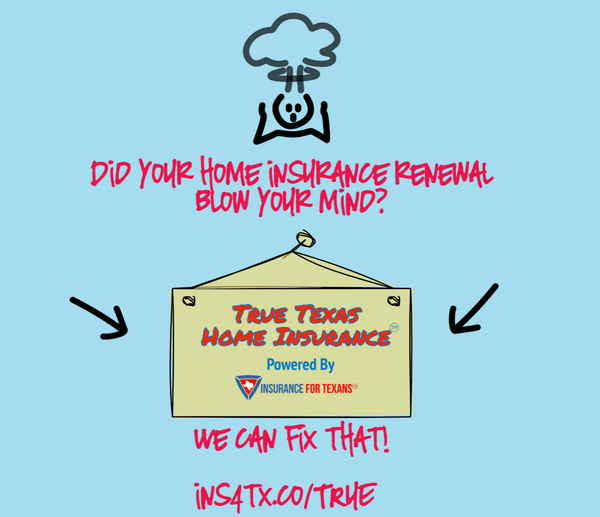The thunderstorm that rolled through Amarillo last night was loud enough that it left Samantha wondering what the outside of her house looked like. The thunder that accompanied the light show was certainly louder than most, but it was the sound of the hail ricocheting off the roof had left her dog cowering in the closet. She walked out the front door and could see the limbs on the ground and her heart sank as she realized that she was likely going to have roof damage yet again. But this time around she knew it was going to cost her more out of pocket.
A couple of months ago Samantha had gotten a notice from her homeowners insurance company prior to her renewal. She knew the price had gone up but there was bold print on that notice explaining that her deductible for homeowners insurance was increasing this year. Her company was raising her percentage deductible for wind and hail moved from 1% to 2%. She wasn't completely sure what that meant at the time, but she was sure that it was going to cost her more out of pocket for damages from last night's storm.
It doesn't matter if you live in Amarillo, Ft Worth, or Austin, there are changes happening to your home insurance policy just like Samantha's. As a result of these changes, there are a lot of questions rolling into Insurance For Texans' office about hail claims on Texas homeowners insurance policies. Now that deductibles have increased for many homeowners, roofers being able to completely ignore deductible payments is quickly disappearing. This creates questions around the mechanics of paying the deductible after a home insurance covered claim is approved by the insurance company.
Different companies operate slightly differently, but there are general expectations in the process of paying your homeowners insurance deductibles. Samantha's deductible questions were understanding what the amount was that she will owe and when to pay it. The cost of repairs were going to be large, but the agents in the Insurance For Texans office were able to answer questions about how the claim check would work, how big her deductible amount would be, and when it was due.
Homeowners Insurance Deductible Defined
When Samantha signed up for her Texas home insurance policy, there was a provision in the policy contract that outlined how much of the repair costs or replacement costs that the insurance company would pay and how much of those costs would be an out of pocket expense for her. That portion that is Samantha's responsibility to pay out of pocket is called the Deductible. It is in all types of homeowners insurance that are sold in the state of Texas, and is typically broken down into different amounts depending upon the type of insurance claims made rather than being a policy deductible.
Wind/Hail storms or Hurricanes have percentage-based deductibles as a standard. Every insurance claim that is not storm related is typically called an "All Other Peril" deductible and can either be a flat deductible (flat dollar amount) or a percentage-based deductible (percentage of your dwelling coverage) depending upon the definitions of a policy. All deductibles typically have a minimum deductible amount that is dependent upon the location and the type of homeowners insurance deductible that is applicable to each claim scenario. Hurricane deductibles may appear on your policy even though Samantha does not live close to the coast since the same policy can serve the people of Amarillo just as well as it does the people of Corpus Christi. Though the hurricane deductible amount will have a much bigger effect on the homeowners insurance premiums on the Corpus Christi policy.
Do I Actually Have To Pay My Homeowners Deductible?
Samantha started with the question of do I really have to pay my deductible on my homeowners insurance claim? Yes, you and she are legally required to pay your deductible on any claim that is made against your policy whether it be for hail damage, hurricane damage, or water damage from a busted pipe. Part of the reason that companies keep escalating the standard deductibles is because roofers have been waiving them for years telling Texans that it's all a scam.
For a roofer to make money to feed their family, and magically waive thousands of dollars in hail deductibles they have to escalate the value of the claim payment that is made to the homeowners. This has a profound effect on insurance rates as inflated claim payments over a period of time will mean that rates for average homeowners insurance policies will continue to rise significantly.
With enough natural disasters happening in Texas, the homeowners policies are now reducing the insurance coverage offered and the hail deductibles have been increased. This is increasing the out of pocket costs for people like Samantha. It's important to understand the increased out of pocket costs are a direct result of the roofers not actually collecting deductible payments from homeowners like Samantha. Something had to give. It was just a matter of time as the costs of damage have continued to skyrocket which in turn caused the average cost of homeowners policies to skyrocket as well.
How Do I Pay It?
Typically, the contractor is responsible to collect the deductible amount as part of the reimbursement for the repair costs of damage. With many home insurance companies, assuming a replacement cost policy on the roof, will release an amount of money equal to the depreciated value of the roof and other structures affected by the claim event less the deductible owed. This money should be used to make a down payment to the contractor to initiate the work to be completed on the home, with the final settlement payment coming from the carrier once the work on the home is completed and satisfactory. The homeowners insurance company will want proof of that completed work to release those funds for final settlement. If for some reason replacing the roof isn't completed, the funds will not be released on standard homeowners insurance.
When Do I Pay It?
Working from the assumption that the home insurance company pays a depreciated amount up front and the remainder once work is completed, the final settlement is when the deductible will be due. Samantha understood this as we explained the final settlement phase is when the funds are released to her when work is completed. When the payment is made, the contractor should issue a receipt in case there is a question around that payment from your insurance provider. Samantha now felt ready to tackle this project.
If you aren't sure whether or not you have a 1% deductible or a 3% deductible on your home policy, or even whether it is replacement cost or actual cash value, you should speak to an independent insurance agent at Insurance For Texans today. True Texas Home Insurance is a blueprint for Texas homeowners like Samantha to understand what your policy does, how it works, and why it's important. We have the tools and are insurance experts that make sure your home and it's policy match up to what you expect them to do for you if disaster strikes! Click the button below to get started with a review of your coverage and how you can make sure that you don't lose an arm AND a leg when you have a hail claim in Texas.






